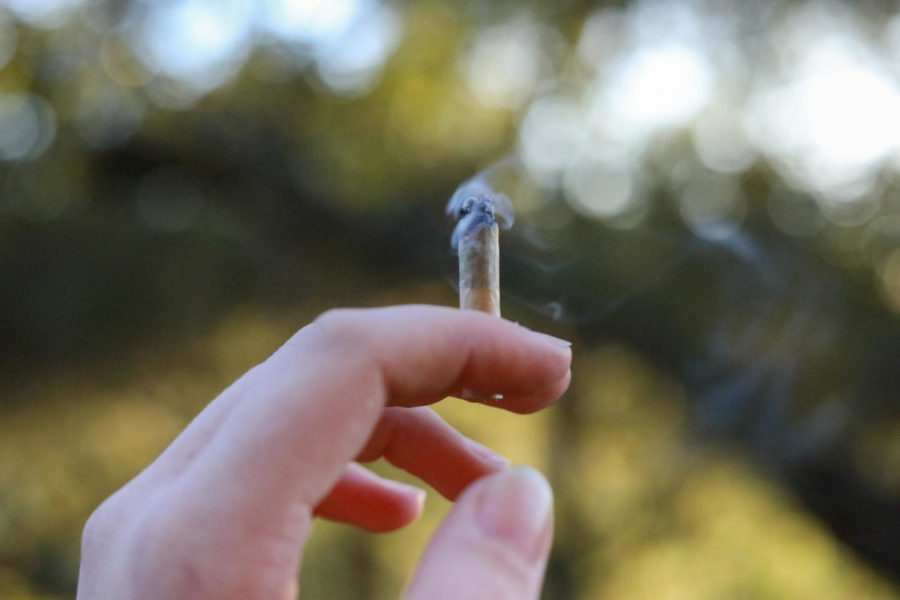Is AWHS a “stoner school?”
Lifetime marijuana usage increased 31 percent among AWHS freshman and juniors, according to a 2018 Healthy Kids Survey.
Ever since its legalization in 2016, marijuana has become more widely available for recreational users. Although it’s not legal to buy or consume marijuana until the age of 21, Tamalpais Unified High School District (TUHSD) high school students have found themselves in a recent surge of marijuana usage.
According to the Missouri State Medical Association, levels of Tetrahydrocannabinol (THC), the main compound in marijuana that gives users a high, has been steadily increasing throughout the years. In the 1960s, THC levels in marijuana were less than two percent, and can now reach as high as 17 to 28 percent. This 212 percent increase in THC levels leads to a more intense high and increases the likelihood of addiction.
None of the TUHSD are strangers to marijuana, especially not AWHS. According to results from the 2018 Healthy Kids Survey, funded by the California Department of Education, 29 percent of freshmen and 60 percent of juniors at Archie Williams High School (AWHS) reported having used Marijuana within their lifetime. Between freshman and junior year, the average usage increased by 31 percent. The marijuana usage of AWHS students between freshman and junior year grew at a higher rate than Redwood students, who started the same at 29 percent usage for freshman year, but only rose to 53 percent by junior year (showing a 24 percent average increase from freshman to junior year). While Tam high school students started with more freshmen using marijuana at 39 percent, the numbers increased at a lower rate throughout high school than at AWHS, rising to 67 percent by junior year (showing a 28 percent increase from freshman to junior year).

Of the 60 percent of AWHS juniors who had used marijuana, 49 percent had done so four or more times. While this statistic doesn’t necessarily mean that these students were addicted, it may suggest that the drug became a part of their lifestyle.
In addition to inciting risk of addiction, marijuana use among teenagers has been linked with depression and anxiety, as well as suicidal thoughts. Research also suggests that when a teenager smokes marijuana during, it may increase the risk for developing psychosis (in people with a genetic risk for developing schizophrenia), according to the National Institute on Drug Abuse. Similar to cigarettes, the smoke from marijuana can cause lung irritation; however, research has not found a strong association between marijuana and lung cancer.
Regardless of the risk, many AWHS students frequently smoke marijuana during their high school careers. Whether or not one participates in using recreational marijuana, the substance has an undeniable prevalence at AWHS, on and off-campus.
AWHS senior Finn McKitterick chooses not to smoke, but would consider AWHS a “stoner school” since he knows countless people who regularly smoke and has noticed students high in class. However, he respects people’s choice to smoke just as they have respected his choice to abstain.
“Like probably fifty percent of the people at our school are high or have been high in their lives. Yeah, I see kids high in class, but I don’t care, it’s their own education. I feel like adults blow the issue of marijuana out of proportion, it’s not a big problem,” Finn said.
An AWHS sophomore, who chooses to remain anonymous and will go by the name “Stacey,” has been smoking since freshman year, turning it into almost daily usage.
“I feel like I would’ve started either way but part of me wishes I didn’t do it as much, I would say I feel a bit of a dependence,” Stacey said. “I’ve been high at school like once or twice but it’s certainly not a regular thing.”
Although marijuana is illegal to buy underage, it has not been much of a problem for Stacey to find.
“I just get [marijuana] off people from social media, usually I’ll get STIIZZYs [rechargeable vape device containing marijuana pods]. I’d say probably a mix of edibles, STIIZZYs, and dab pens are the most popular, and then bud is too but it isn’t as convenient because of the smell,” Stacey said. Although Stacey thinks that marijuana is normalized at AWHS, she doesn’t think it’s the school’s most popular drug.
“I’d say [for the most used substance among students] nicotine is first, then weed, then alcohol, I don’t really know about hard drugs here,” Stacey said. “I think every school is probably the same [considering marijuana usage] but I feel like we have more freshmen this year that smoke than the other schools.”
Although studies from the Centers for Disease Control and Prevention (CDC) say that 3 in 10 marijuana users have marijuana use disorder, Lynnette Shaw, founder of Marin Alliance for Medical Marijuana, still believes that teenagers should decide for themselves when they begin experimenting with marijuana. Shaw also says that adults shouldn’t try to use “scare tactics,” such as frightening statistics, to dissuade teens from using marijuana.
“When a young person tries marijuana and they don’t die and they don’t hallucinate and they don’t start killing people, or whatever it is they are being told, then they don’t believe anything else that is being told to them by the adults about drugs,” Shaw said.
AWHS Wellness Coordinator Katrina Southard has dealt with many teenage marijuana users and recognizes that marijuana is not as addicting as hard drugs such as cocaine or heroin, but can still be addictive. Southard says that if a user consumes marijuana for the sole purpose of feeling high, rather than for medicinal purposes or relaxation, they may develop dangerous brain patterns that revolve around marijuana use. For teenagers, whose brains are still developing, she says this could be quite dangerous.
“Whatever brain pattern you get into during your youth is a likely brain pattern that might continue because it’s while your brain is forming,” Southard said. “So, if you smoke weed one time during your high school career it’s probably not going to have an impact on your lifelong development, but if you smoke weed every day, your brain pattern can start developing around that pattern.”
A Tamalpais (Tam) High School junior, who chooses to remain anonymous and will go by the name “Jamie,” says that Tam students smoke just as much as AWHS, maybe even more.
“Tam is definitely known for weed, it’s the main drug other than nicotine, which is everywhere. I’ve got some good friends from [AWHS], and from talking to them it sounds like the drug scene is similar to Tam, maybe a little bit less just because it’s a smaller school. It sounds like [marijuana is] used in a more controlled, and I guess smarter way than people at Tam partake in it,” Jamie said. “From what I’ve seen, Tam does not have a lot of hard stuff going through it, like Redwood. I see a lot of cocaine and even some heroin going through Redwood.”
Although many of Jamie’s friends smoke, he has never used marijuana as he sees it as a waste of money.
“I do have friends who have really really kind of gone off the deep end with it and that’s really sad to see because I miss the people that they were before they were high all the time,” Jamie said. “Not once have I felt peer pressured into it by my friends. All my friends who partake in substances are extremely respectful of my sobriety and applaud me for my stance and my position on it.”
Despite the risks of excessive marijuana usage, some TUHSD students still feel drawn to this drug. AWHS offers the support of guidance counselors and peers for students to make their drug-usage decisions with the utmost knowledge and safety.

Henry is a senior in high school, who loves to play tennis and enjoys spending time outdoors hiking.

Corina is a senior, in her third year of journalism. You can often find her at a concert and spending time with friends. She loves Mexican food and listening...

Naomi is a senior, in her first year of journalism. She loves surfing, mountain biking, and going to Scoop. You can find her at Bolinas surfing and hanging...









Alex E • Oct 9, 2022 at 11:53 PM
Very informative and interesting piece!